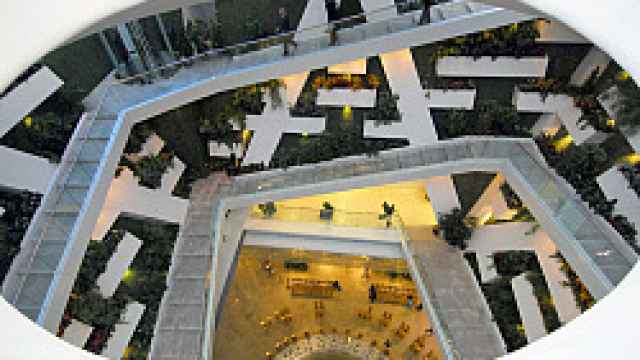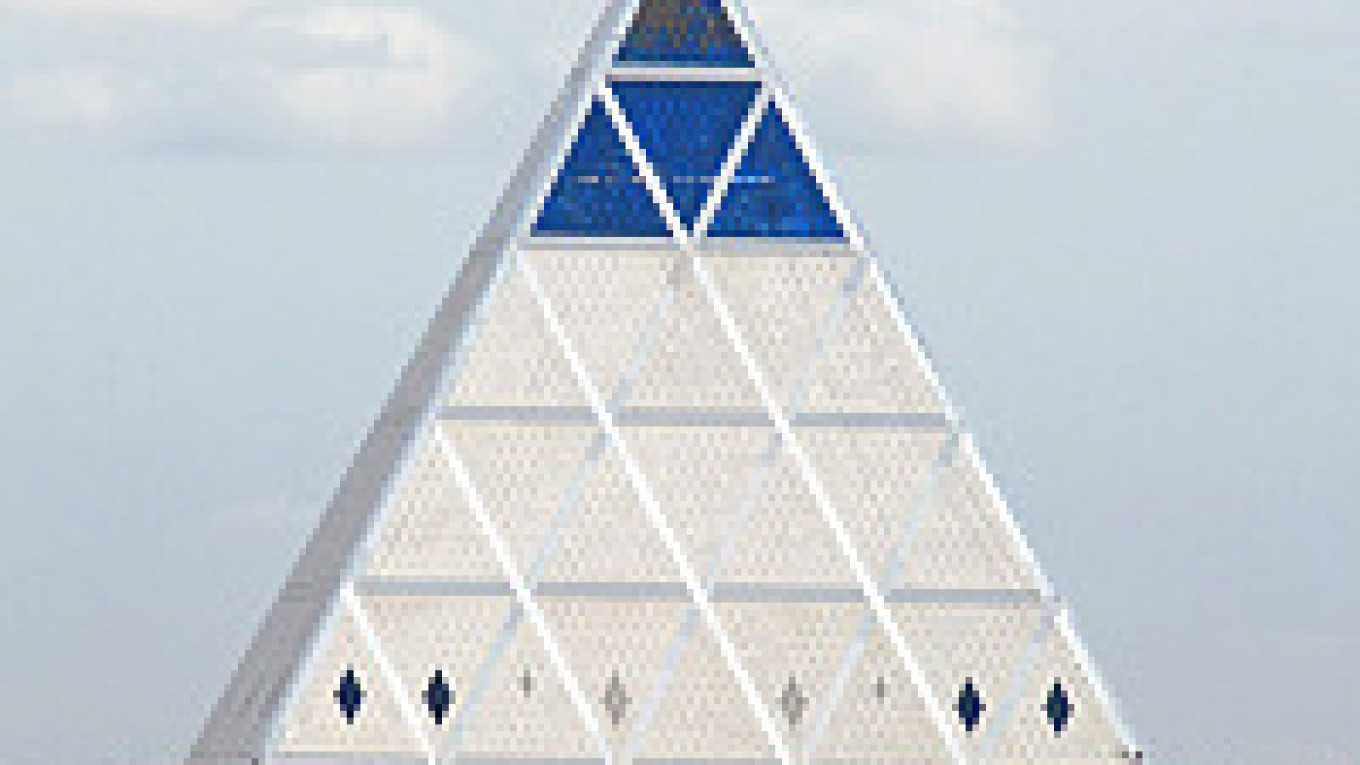That was the message given to British architect Lord Norman Foster by the president of Kazakhstan four months into designing a pyramid in the capital city, Astana.
The resulting 62-meter-high Pyramid of Peace and Accord, constructed in less than two years, juts out into the barren plain behind Kazakh President Nursultan Nazarbayev's palace.
Sounds odd? Astana, a Brasilia of the steppe, is like that.
Nazarbayev moved the capital here in 1997 and has poured billions of dollars of revenues from oil, gas and metals exports into the construction of a new city in the middle of the vast, empty heartland of the world's ninth-largest country.
The pyramid is the first building in Astana designed by a big-name architect like Foster, famous among other things for the glass cupola on Berlin's Reichstag and the Swiss Re tower in London that is nicknamed the "gherkin."
Nazarbayev commissioned his pyramid to host a congress of world religious leaders, an event he dreamt up to put Kazakhstan on the map as a serious player in global affairs and to show it is not just another former Soviet republic.
Foster, 71, squeezed in the 1,500 seat opera house -- a bit bigger than one at Glyndebourne in Britain -- as well as offices, "hanging gardens" and a huge atrium.
The pyramid is topped by a transparent peak where a doughnut-shaped meeting table hovers in mid-air.
"It was quite challenging," Foster said by telephone from Foster and Partners in London. "Typically, you would be thinking six to eight years for such a cultural project.
"If somebody says, 'Hey there's this congress meeting point/public space/university/exhibition space and we need it in two years,' you know, that makes your pulse quicken and slightly takes your breath away," he said.
"If you then, four months into that process, say, 'Well, we'd like to put a Glyndebourne in, sorry it's a bit bigger than Glyndebourne, but we'd like to put it underneath ..." Foster trailed off.
For an architect known for his use of neutral colors and glass and steel, it is also something of a departure, as most of the building is windowless, with only the apex clad in glass.
Sunlight filtered by yellow and blue stained-glass windows designed by Brian Clarke, a British artist and long-term Foster collaborator, streams down into the pyramid's cavernous atrium.
The opera house below is predominantly red. Perhaps heaven and hell are not the right comparisons, but Foster describes his building in symbolic terms.
 Reuters The pyramid's interior features an atrium and this breathtaking vertical drop. | |
"As you ascend up the pyramid you ascend up into the light," he said.
Another Foster theme, breathtaking vertical drops that are enough to give most people wobbly legs, is certainly present.
From the doughnut-shaped dais suspended at the top of the pyramid there is a sheer drop down to the ground floor of the atrium, which is also the roof of the opera house.
Foster said he was intrigued at the prospect of building a pyramid that would be "so light that it will appear to float away," in contrast to the massive and solid historical pyramids.
He declined to comment on the rest of Astana's architecture, but his pyramid certainly stands out, both as a gesture by Nazarbayev and as a piece of architecture.
"It's an unbelievable folly, in the sense that it's a grand monument by one man to himself," said Hugh Pearman, editor of the Royal Institute of British Architects' monthly RIBA Journal. "[But] it has merit."
The city rapidly developing around the pyramid, built according to a master plan laid out by Japanese architect Kisho Kurokawa, is not -- yet -- loved by the locals, the richer of whom try to escape to the former capital Almaty in the south on weekends.
The left bank of the Ishim river that bisects the city consists of Nazarbayev's palace, ministries, monuments and building sites while the more lively right bank comprises mainly Soviet-era residential buildings and the old town center.
A bracing wind blows all year round, bringing temperatures that can hit 40 degrees Celsius in the summer and sink to minus 40 C in the winter -- another factor that complicates construction.
Most new buildings in Astana glitter with reflective surfaces or bewilder the eye with intricate colonnades and other baubles. The style is politely termed postmodernism by architects.
There is also a trend to hark back to Soviet architecture. One new tower block is a garish modern replica of one of the Stalin-era skyscrapers in Moscow known as the Seven Sisters -- right here at the heart of the gulag archipelago, where the Soviet dictator sent millions to die.
For an architect like Foster, the pyramid was not only an entry into a market awash in petrodollars -- he is now involved in a proposal for an enormous indoor leisure center dubbed the Khan's tent -- it was also a chance to experiment.
"For a British architect, the fact that you will see your vision completed in, like, 18 months is a powerful inducement," said Pearman, the architecture critic. "He can use Astana as a testing ground. ... it can be regarded as rapid prototyping."
In the weeks running up to the opening at the beginning of September and to the religious congress, workers hired by the Turkish constructors toiled around the clock to get things finished. Several hundred soldiers were called in to help out.
The result is certainly rough around the edges. The odd leak in the roof, missing screws, splintered glass panes and a lot of building dust and debris, but that is common in Kazakhstan.
"Not surprisingly, there's a long snagging list of things to be properly finished and tidied up and sorted out," Foster said.
Pearman, who visited the site during construction, described it as the scariest he had seen in terms of safety, but added that Western architects faced the choice of working with local conditions or not working at all in countries like Kazakhstan.
And does he feel that the pyramid improves Astana?
"The city doesn't at the moment feel like a friendly place, it feels very much like an administrative center," he said. "One craves a little corner cafe or something like that. But it's early days."
A Message from The Moscow Times:
Dear readers,
We are facing unprecedented challenges. Russia's Prosecutor General's Office has designated The Moscow Times as an "undesirable" organization, criminalizing our work and putting our staff at risk of prosecution. This follows our earlier unjust labeling as a "foreign agent."
These actions are direct attempts to silence independent journalism in Russia. The authorities claim our work "discredits the decisions of the Russian leadership." We see things differently: we strive to provide accurate, unbiased reporting on Russia.
We, the journalists of The Moscow Times, refuse to be silenced. But to continue our work, we need your help.
Your support, no matter how small, makes a world of difference. If you can, please support us monthly starting from just $2. It's quick to set up, and every contribution makes a significant impact.
By supporting The Moscow Times, you're defending open, independent journalism in the face of repression. Thank you for standing with us.
Remind me later.


